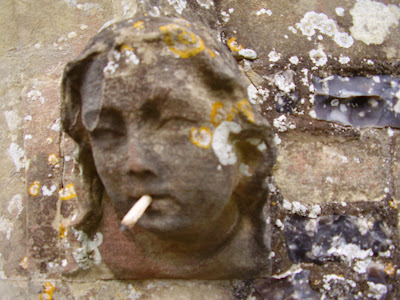If this is correct then the assumption that we¬the inner self¬have thoughts that we choose to put into language to communicate with our fellows is an illusion, for there can be no inner-self. 

Bom, já chega de estruturas, chegou mesmo a prima Vera, uma das últimas pós-estruturalistas precoces no activo. Cães, Impulse, Koons, porquê? Tem havido aí uma matilha de simpáticos cães no ciber-espaço que vou lambendo com os olhos, e nos livros que vou frequentando . Hoje fui visitar a Frioleiras depois de tanto tempo e lá estava mais um cão do Koons.
A mim, (in)pessoalmente o que me interessa mais é perceber porque é que o Gonçalo Tavares coloca a metáfora "des-estruturalista" da terra encharcada a desabar em cima de um homem, matando-o, em conjunção com o "desabar das certezas" desse homem, e fá-lo exactamente no mesmo capítulo em que alude à tristeza enquanto um cão que obedece aos poetas, mas que é perigoso,
talvez sem saber que Bukowsky aludiu ao amor como um "cão do inferno" ao mesmo tempo que o mesmo Bukowsky deixa desabar em cima de si as estruturas do parentesco.
A grande pergunta é: "E se um cão (do inferno) de repente lhe oferecer flores?"
"Boa" questão.
"Muito Boa" questão. Não é?
Ão é? Ou apenas mais uma "falsa" questão?
Perdão, isto ão é um blog. Mas mesmo assim não vale a pena exagerar.

Thus the subtle anti-ego and anti-individualist stance of the currently respected Post-modern thinkers, Barthes, Derrida and Foucault, when translated into the field of art becomes far more concrete and determinate than in its original context. This is the pessimistic side for this situation: since Romanticism, art has stood for the liberation of the inner self that is supposedly suppressed by the higher consciousness (our internal representative of society at large) thus art has stood for individuals against a social norm. Now Post-modernism, along with the Post-structuralist thought that informs it, objects to this view as fundamentally false in its model of what we as human beings are...
If this is correct then the assumption that we¬the inner self¬have thoughts that we choose to put into language to communicate with our fellows is an illusion, for there can be no inner-self....
The further insight that Post-structuralism has supplied concerns the idea that we are imprisoned within language¬it circumscribes what we can say and what we can know. This appears to some to be a branch of skepticism.
[...] Collings: Do you really work at upsetting people?
Koons: I never do anything just for shock value. I'm only interested in developing art and freeing it, so that artists can be more liberated in what they do. I'm just showing what's necessary in order for the work to be really effective [...] I point to that sort of thing because it's an example of what everybody faces every day of their lives; when they have an opportunity to be really effective, that's exactly the moment when they back off. Effectiveness is power and the exercise of power. And that's what separates the men from the boys.
Collings: I suppose viewers might wonder what these sort of considerations have to do with art . . .
Koons: Yes, I find that difficult to understand.


_1.jpg)














































